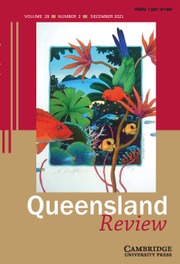No CrossRef data available.
Article contents
Frank Wesley: The Queensland years
Published online by Cambridge University Press: 02 November 2021
Abstract
A little-known piece of Queensland’s art history is that the Indian artist Frank Wesley lived and worked in Queensland for nearly thirty years. From Azamgarh, Uttar Pradesh, Wesley completed his art studies in India, Japan and the United States. He won the competition to design the urn that would hold the ashes of Mahatma Gandhi and had paintings exhibited in the Vatican Museum in Rome in 1950. His Blue Madonna painting was reproduced on the first UNICEF Christmas card. Wesley spent the last third of his life in Nambour. While he may chiefly be considered a watercolourist in the Indian Lucknow style, his media and practice were far more diverse. This article seeks to provide a brief overview of the work achieved by Wesley over this time, featuring biblical and Christian themes, and also landscapes and figurative pieces in a wide range of media and styles from various traditions. Among these are styles that emerged in more distinctive ways during his Nambour years, including the incorporation of the human figure or the hand of God in the landscape after seeing Indigenous rock art, and also the contrasting designs for two stained-glass windows.
- Type
- Articles
- Information
- Copyright
- © The Author(s), 2021
References
Notes
1 Naomi Wray, Frank Wesley: Exploring faith with a brush (Auckland: Pace, 1993), pp. 177–80.
2 See Wray, Frank Wesley, pp. 12–13 for a description of the technique; also Shefali Bhatnagar, Variegated vista: Painting, sculpture and printmaking in post-independence Uttar Pradesh, (Gurgaon: Shubhi, 2011), p. 57.
3 Wray, Frank Wesley, pp. 41, 44–5.
4 See Masao Takenaka, Christian art in Asia (Tokyo: Kyo Bun Kwan, 1975) for a discussion of Asian ethnic and cultural identity and the work of Asian Christian artists, as this question was explored in the 1960s and 1970s.
5 Wray, Frank Wesley, p. 9.
6 Wesley gave me permission to print copies of the three woodblocks, Magdalene, Christ at Cana, and the large Forgiving Father in the 1990s. Each relates to a painting of the same name. These woodblocks are now housed in the Art Department at the Australian Catholic University, McAuley Campus, Banyo.
7 Wray, Frank Wesley, pp. 212–13.
8 Wray, Frank Wesley, pp. 166–7.
9 Images of these paintings and many others can be seen on the website www.frankwesleyart.com in the Religious Art section [27 March 2021]. However, these images are often unreliable in relation to colour reproduction.
10 Wray, Frank Wesley, p. 177. It was a traditional understanding that a student did not claim full right to a work until after the death of the teacher/guru.
11 Wray, Frank Wesley, p. 75.
12 A small reproduction of this may be seen on the website www.frankwesleyart.com. It now hangs in the Uniting Church Centre for Ministries in Parramatta.
13 Krishna Chaitanye, A history of Indian painting: The mural tradition (New Delhi: Abhinav, 1976) gives an account of studies of this ancient Ajanta rock mural art over its 1000-year history (perhaps 200 BCE to 800 CE), an art tradition rediscovered in the nineteenth century.
14 Takenaka, Christian art in Asia; and Masao Takenaka and Ron O’Grady, The Bible through Asian eyes (Auckland: Pace, 1991).
15 Ron and Alison O’Grady (eds), Twenty years: A celebration of the Asian Christian Art Association 1978–1998 (Hong Kong: Clearcut, 1998), p. 25.
16 Geoff Wheaton tells the story of this as part of his spiritual reflection on the painting on the website https://pathwaystogod.org/resources/forgiving-father-frank-wesley [27 March 2021].
17 There were also questions of a conflict of interests because of Professor Wesley’s position on the Art Gallery board; he also sensed that such promotion would have been inappropriate in the light of his father’s approach to advertising his work.
18 Wray, Frank Wesley, p. 179.
19 Wray, Frank Wesley, p. 210.
20 Wray, Frank Wesley, p. 185.
21 Wray, Frank Wesley, p. 199.
22 Wray, Frank Wesley, p. 191.
23 Martin Edmond, Battarbee and Namatjira (Sydney: Giramondo, 2014), p. 194 expresses the understanding that Namatjira’s landscapes often embody ambiguous presences, totemic beings.
24 Wray, Frank Wesley, pp. 126–7.
25 An account of this is available in a booklet produced by Cromwell College, The stained glass windows of Cromwell College, which can be found on the college website. Available from http://cromwell.uq.edu.au/history/griffin-memorial-chapel-windows [27 March 2021].
26 Luke 10: 29–37
27 Wray, Frank Wesley, p. 214.
28 Wray, Frank Wesley, p. 75.
29 Wray, Frank Wesley, p. 97.
30 Wray, Frank Wesley, p. 51.
31 Wray, Frank Wesley, p. 123.
32 Timothy Verdon (ed.), Art and theology in ecumenical perspective (Brewster, MA: Paraclete Books, 2019), p. 77.
33 Pelgrim in Gods hand, De Indiase Schilder Frank Wesley (Missie-Zendingskalender, 1996).
34 Word Among Us, Learner’s Guide, Year 2 (Cleveland, OH: United Church Press, 1995), using Wesley’s Jai Christ for Pentecost 6, p. 97.
35 Naomi Wray, ‘Frank Wesley’, in S.J. Anand Amaladass and Gudrun Lowner (eds), Christian Themes in Indian art: From Moghul times until today (New Delhi: Manshor, 2012), p. 246.
36 William Dyrness, Christian art in Asia (Amsterdam: Rodopi, 1979); and Takenaka, Christian art in Asia, p. 109.
37 Lee Duncan, ‘Frank Wesley: Crossing cultural boundaries’ Journey, December 1991, pp. 28–9.
38 Available from https://indiaartsmovement.wordpress.com/2015/09/25/frank-wesley-rediscovering-the-global-artist-from-azamgarh [27 March 2021].
39 Verdon, Art and theology in ecumenical perspective, p. 77.
40 Caroline Blyth and Nasili Vaka’uta (eds), The Bible and art: Perspectives from Oceania (London: T & T Clark, 2018), pp. 275–93.



